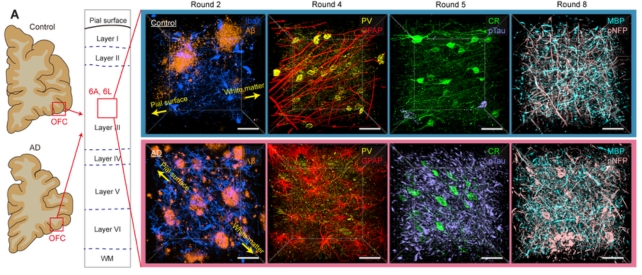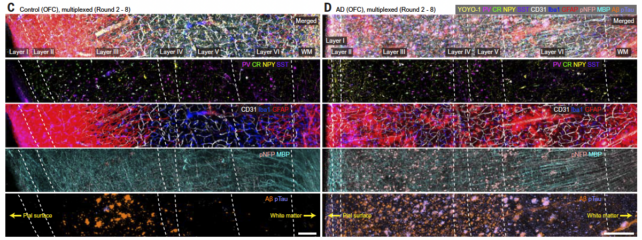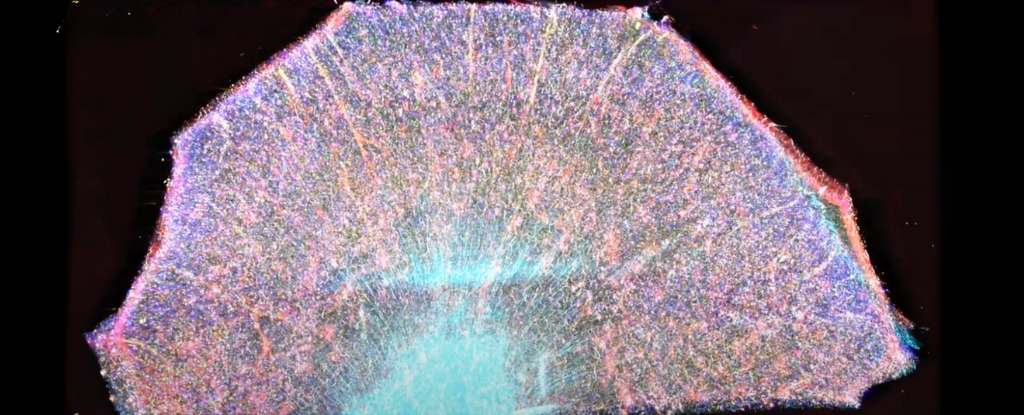Researchers will no longer need to choose between studying a single human brain as a patchwork of fragmented images or a distant, pixelated view of large structures.
A new imaging platform developed by a US team instead seamlessly combines the finer details of brain cells, their connections and contents, with brain-wide maps of whole networks of neurons holding up the brain’s overall architecture.
These elements of brain biology exist on wildly different scales, from the nanometer-sized gaps of synapses to centimeter-long brain regions, which have until now required multiple samples from multiple brains to analyze using various technologies on different platforms.
In its first demonstrated use on human tissue, imaging two whole brains, the platform has revealed distinct changes in the brain of one person with Alzheimer’s disease.
The new platform includes three core elements to slice, process, and then image brain tissues with “unprecedented resolution and speed”, according to the research team that developed it, led by Kwanghun Chung, a chemical engineer at Massachusetts Institute of Technology (MIT).
First, an innovative device slices brain tissue into sections. It uses carefully tuned vibrations to avoid abrasion, separating cells cleanly as incredibly thin slices without dislocating their connections.
Then a chemical technique reversibly transforms those tissue sections into a stretchy, expandable tissue-hydrogel ripe for antibody tagging and high-resolution imaging of proteins and other internal things.
Finally, a computational tool ‘stitches’ the sliced tissues back together and maps the connections between individual cells. Those ‘projectomes’ of single brain cells can then be integrated with profiles capturing the molecules expressed in each cell.

“We need to be able to see all these different functional components – cells, their morphology and their connectivity, subcellular architectures, and their individual synaptic connections – ideally within the same brain” to be able to compare whole brains and find individual differences, says Chung.
“This technology pipeline really enables us to extract all these important features from the same brain in a fully integrated manner.”
The tissue-turned-hydrogel gently inflates tissue sections so they can be imaged clearly; and a pump steadily infuses the tissues with fluorescent dyes to produce consistent staining across whole organs.
In a dizzying display of the platform’s imaging capabilities, the researchers provide examples where they labeled one whole brain hemisphere, then zoomed in to take a snapshot of cell circuits, followed by single cells and their connections across junctions called synapses.
frameborder=”0″ allow=”accelerometer; autoplay; clipboard-write; encrypted-media; gyroscope; picture-in-picture; web-share” referrerpolicy=”strict-origin-when-cross-origin” allowfullscreen>
As for how the platform reconstructs those connections across multiple tissue sections, the computer tool has an algorithm that matches blood vessels exiting one layer and entering the adjacent one, and traces the extensions of neighboring neurons, called axons.
Putting it all together, the researchers imaged the whole brains of two generous donors, one with Alzheimer’s disease and one without.
They uncovered the usual pathological features of Alzheimer’s, including the buildup of amyloid plaques and tau tangles, and shriveling brain cells, but their imaging also captured some finer differences.

The axons of brain cells in the Alzheimer’s patient were swollen. Brain cells in regions laden with tau and amyloid proteins had also lost their protective myelin covering and withdrawn from their neighbors.
This “supports neuroimaging studies that suggest severe damage to the connectivity of the orbitofrontal cortex in the late stages of Alzheimer’s disease,” the team writes in their paper.
However, this gallery represents only one snapshot in time of just two brains.
frameborder=”0″ allow=”accelerometer; autoplay; clipboard-write; encrypted-media; gyroscope; picture-in-picture; web-share” referrerpolicy=”strict-origin-when-cross-origin” allowfullscreen>
Scientists have produced some remarkably detailed images of the human brain lately, zooming in on a single cubic millimeter of brain tissue – a decade-long effort that ultimately produced 1.4 petabytes of data.
Imaging how the brain changes as it slowly degenerates in diseases like Alzheimer’s is a somewhat harder task because researchers are often working with post-mortem brain tissues donated at the end of someone’s life, or relying on traditional whole-brain scans such as MRI, hoping to detect changes before the disease sets in.
It’s also not clear yet how the platform might adapt to advances in brain imaging that are rapidly unfolding, but the team is optimistic that their system will help spur the development of new therapies and maximize the amount of information extracted from valuable donor tissues.
“This pipeline allows us to have almost unlimited access to the tissue,” Chung says. “We can always go back and look at something new.”
The study has been published in Science.

Dr. Thomas Hughes is a UK-based scientist and science communicator who makes complex topics accessible to readers. His articles explore breakthroughs in various scientific disciplines, from space exploration to cutting-edge research.








